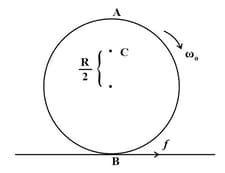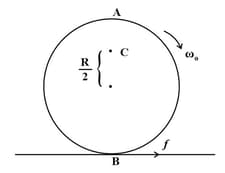Rolling Motion
Important Questions on Rolling Motion
Read the statement below carefully, and state, with reasons, if it is true or false:
A wheel moving down a perfectly frictionless inclined plane will undergo slipping (not rolling) motion.
Read the statement below carefully, and state, with reasons, if it is true or false:
For perfect rolling motion, work done against friction is zero.
Read the statement below carefully, and state, with reasons, if it is true or false:
The instantaneous speed of the point of contact during pure rolling is zero.
Read the statement below carefully, and state, with reasons, if it is true or false:
During rolling, the force of friction acts in the same direction as the direction of motion of the CM of the body.
Read the statement below carefully, and state, with reasons, if it is true or false:
The instantaneous acceleration of the point of contact during rolling is zero.
Separation of Motion of a system of particles into motion of the centre of mass and motion about the centre of mass:
Show
where is the total kinetic energy of the system of particles, is the total kinetic energy of the system when the particle velocities are taken with respect to the centre of mass and is the kinetic energy of the translation of the system as a whole (i.e. of the centre of mass motion of the system).
A cylinder of mass and radius is rolling perfectly on a plane of inclination . The coefficient of static friction . How much is the force of friction acting on the cylinder? What is the work done against friction during rolling? If the inclination of the plane is increased, at what value of does the cylinder begin to skid, and not roll perfectly?
A solid disc and a ring, both of radius are placed on a horizontal table simultaneously, with initial angular speed equal to . Which of the two will start to roll earlier? The co-efficient of kinetic friction is
Explain why friction is necessary to make the disc in Figure, roll in the direction indicated. Give the direction of frictional force at , and the sense of frictional torque, before perfect rolling begins. What is the force of friction after perfect rolling begins?
A disc rotating about its axis with angular speed is placed lightly (without any translational push) on a perfectly frictionless table. The radius of the disc is . What are the linear velocities of the points , and on the disc shown in Figure? Will the disc roll in the direction indicated?
Prove the result that the velocity of translation of a rolling body (like a ring, disc, cylinder or sphere) at the bottom of an inclined plane of a height is given by using dynamical consideration (i.e. by consideration of forces and torques). Note is the radius of gyration of the body about its symmetry axis, and is the radius of the body. The body starts from rest at the top of the plane.
A solid cylinder rolls up an inclined plane of angle of inclination . At the bottom of the inclined plane the centre of mass of the cylinder has a speed of . How far will the cylinder go up the plane? How long will it take to return to the bottom? (Friction between cylinder and incline plane is sufficient for pure rolling).
A hoop of radius weighs . It rolls along a horizontal floor so that its centre of mass has a speed of . How much work has to be done to stop it?
A solid sphere rolls down two different inclined planes of the same heights but different angles of inclination.
Will it reach the bottom with the same speed in each case? Will it take longer to roll down one plane than the other? If so, which one and why?


